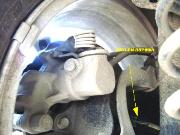Mazda 3 air conditioner and heater design
Mazda 3 vehicles are equipped with an automatic air conditioning system.
The air conditioning system uses a full-flow aluminum heater core with rectilinear circulation
Heat transfer efficiency is increased by using an additional evaporator.

The electronic control unit of the air conditioner has a self-diagnosis function.
A system fault is stored in the DTC memory and the A/C switch indicator flashes.
Safety measures when servicing the air conditioner
Refrigerant Handling
Do not inhale air conditioner refrigerant or lubricant fumes. Possible irritation to eyes, nose and throat.
In addition, for environmental reasons, we strongly recommend using recovery/recycling/recharging equipment when removing R-134a refrigerant from the A/C system.
In case of accidental leakage from the system, ventilate the work area before resuming service.
Do not perform pressure or leak tests on service equipment and/or the vehicle's air conditioning system using compressed air.
Some mixtures of air and R-134a have been shown to be flammable at elevated pressures.
These mixtures can cause personal injury or property damage if ignited.
For further health and safety information, contact the refrigerant manufacturers.
Do not allow refrigerant to leak near open flames or heat sources.
Poisonous gas can be generated when the refrigerant comes into contact with an open flame or heat source such as a cigarette and a heater.
When performing work that may cause a refrigerant leak, extinguish or remove the indicated heat sources and provide adequate ventilation.
Hazardous handling of liquid refrigerant.
Skin contact with refrigerant can cause local frostbite.
Wear gloves and goggles when handling refrigerant.
If refrigerant gets into your eyes, rinse them immediately with clean water and consult a doctor.
Refrigerant storage
The refrigerant container is under pressure.
If the container is heated, it may explode, dispersing metal fragments and liquid refrigerant, causing serious injury.
Store refrigerant below 40°C.
What to do if there is insufficient refrigerant
If insufficient refrigerant level is found during troubleshooting, do not recharge (add) refrigerant.
Because the exact amount of refrigerant cannot be determined from the pressure in the system, never recharge the system with refrigerant.
If there is too little or too little refrigerant, there may be secondary faults in the system, such as damage to individual components or deterioration in system performance.
Therefore, if insufficient refrigerant level is detected, completely remove the refrigerant from the system and charge the specified amount of refrigerant.
Compressor oil handling
Use only ATMOS GU10 oil in the compressor of this car.
Using PAG oil instead of ATMOS GU10 may damage the air conditioning compressor.
Be careful not to spill ATMOS GU10 on the car.
Oil on the surface of the car can damage the paintwork.
If oil gets on the car body, wipe it off immediately.
ATMOS GU10 compressor oil (PAG oil) absorbs moisture more effectively than previously used mineral oil.
If moisture gets into the compressor oil, the air conditioning system may be damaged.
Therefore, to prevent moisture from entering the oil, install caps immediately after using compressor oil or removing A/C components.











